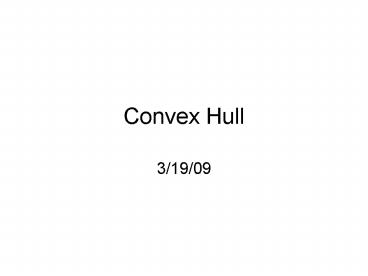Convex Hull - PowerPoint PPT Presentation
1 / 27
Title:
Convex Hull
Description:
Is C counterclockwise as seen going from A to B? A. B. C. Useful code ... Use min and max points in x and y; sweep down from the top. Divide and conquer ... – PowerPoint PPT presentation
Number of Views:305
Avg rating:3.0/5.0
Title: Convex Hull
1
Convex Hull
- 3/19/09
2
Warmup
- Points in the plane P (x, y)
- in code P.x, P.y
- Vectors differences between points
- v Q P means v is what youd add to P to
get to Q - Computationally vx Qx Px sim for y.
- Notation written vertically
- x
- y
3
More vectors
- Vertical notation is a pain instead we write
- v x yt the small t means transpose or
flip over to make this vertical. - Can add, subtract pairs of vectors
- Can add vectors to points
- Can rotate a vector 90 degrees counterclockwise
- if v x yt, then vr -y xt
- is 90 degrees CCW from v
4
More Vectors
- Can use vectors to compare directions.
- If v a bt and w c dt, then v . w is
defined to be ac bd. - v . w is positive if and only if v and w point in
the same half-plane (i.e., angle between them is
less than 90 degrees) - v . w 0 if either v or w is zero, or if theyre
perpendicular
5
Useful code
- Is C counterclockwise as seen going from A to B?
C
A
B
6
Useful code
(B-A)r
- Is C counterclockwise as seen going from A to B?
- Yes, if (C B) . (B A)r gt 0.
C
A
B
7
CCW(A, B, C)
- Assumes that A, B, C distinct
- boolean CCW(Point A, Point B, Point C)
- Vector v new Vector(B.x A.x, B.y A.y)
- Vector w new Vector(C.x B.x, C.y B.y)
- return (Dot(Perp(v), w) gt 0)
8
More utility code
- Represent a polygon as a sequence of points
- First and last points NOT equal (i.e., we dont
duplicate the last point) - Could have made opposite choice
9
Inside testing
- Assumes no two points the same, no three
collinear - boolean Inside(Point Q, Polygon P)
- boolean inside false
- for each edge E (A, B) of P
- if (Q.x between A.x and B.x)
- inside NOT(inside)
- return inside
- Observation this is O(k), where the polygon has
k vertices.
10
Convex Hull Approaches
- Brute force
- Use min and max points in x and y sweep down
from the top - Divide and conquer
- Incremental (really just brute force)
- Angular sweep
11
Brute Force
- for all algorithms special cases for n 1, 2,
3 - boolean BFHull(Points P)
- hull hull for first 3 points.
- for Q in P
- if Q inside hull, do nothing
- else add Q to hull
- return hull
- Observation takes at least n2 ops in worst case,
even ignoring add Q to hull. Inside-testing is
n ops, repeated about n times.
12
Divide and Conquer
- Divide points into two piles (split at some
x-coordinate) - Run CHull on each pile
- Merge together somehow
13
(No Transcript)
14
(No Transcript)
15
(No Transcript)
16
Fix Hull
- Need to get rid of all reflex nodes
- Polygon FixHull(Polygon H, Position P)
- input a polygon H and a position in the
polygon P the polygon may have reflex vertices - output the polygon with all reflex vertices
removed. - Position Q P
- P P.next()
- while P ltgt Q
- S P.next()
- if not CCW(P.prev(), P, P.next())
- remove P from H
- P S
- if not CCW(P.prev(), P, P.next())
- remove P from H
- return H
17
Divide And Conquer
- Divide into two sets of vertices
- Find convex hull for each
- Splice together at rightmost/leftmost nodes of
left and right sub-hulls - FixHull to get rid of reflex vertices.
18
Problems
- Bad splitting need to divide approximately in
half to get efficiency - Could sort by x and split evenlybut that adds an
O(n log n) term - Could compute average x and split there
- very bad idea
19
Max/Min sweep
- Sounds promising
- Amazingly messy and error prone
- Tons of special cases
- Used to be most-hated CS16 project
20
Angular sweep
- Find a center point somehow
- Order all other points by angle relative to
center point - Add them in angular order
21
(No Transcript)
22
Finding Angles
- Angle for ray from P to Q
- v Q P
- angle atan2(v.y, v.x)
- Atan2 returns values from pi to pi
- We prefer 0 to 360 (easier to read!)
- angle (180/pi) atan2(v.y, v.x)
- if (angle lt 0) angle 360
23
Building the CHULL incrementally
- If next point inside CHULL do nothing
- Else
- add next point to hull (just after last one!)
- fixHull backwards from here
24
Building the CHULL incrementally
- Analysis FixHull could do k fixes on the kth
point - Sounds like O(n2)
25
Observations
- Any point can be inserted at most once, and
deleted at most once! - When fix-hull reaches a vert that doesnt need
fixing, it can stop - With O(n) insertions, and O(n) deletions, sounds
like O(n)!
26
Sanity check
- For those insertionswe need to check whether the
new point is insidecould be O(n) - But its not! The new point cant possibly be
inside!
27
Sanity Check 2
- How do we process the points in angular order?
- We have to sort firsttakes n log n time.
- Summary n log n algorithm for CHULL































